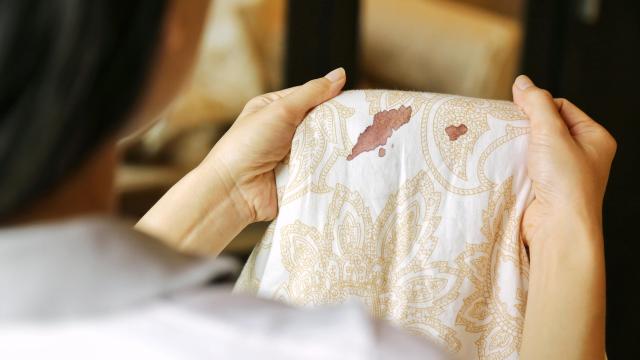If you’re looking for ways to remove blood stains from clothing, walls, or whatever other surface you may have found it on, we’re going to give you the benefit of the doubt regarding any bad behaviour and move straight to solutions — because there are quite a few. Some are better than others, though, so you also need to know what’s not going to get that stain out. Furthermore, blood is not your average stain: It can also be a biohazard, so you’re going to need to know how to do all of this to maximise your safety. Put on your gloves, don’t touch the blood directly, and let’s get into it.
What works to remove blood stains?
First, you need to dab your stain as quickly as possible. The faster the better here. Using a salt water mixture and a sponge or rag, dab at the offending mark. To avoid it setting into your fabrics, you should try to use water on the colder side. If you’re really quick, you can skip the salt water and put the fabric right under cold running water. Add a drop of dish soap directly to the fabric, then gently rub the fabric together, in on itself, to get the blood out.
If you remove your fabric from cold water to discover there’s still a mark on it, grab some hydrogen peroxide. Test a little of the fabric first to make sure it isn’t susceptible to bleaching, then dab some peroxide on with a clean rag. You can also replace the hydrogen peroxide with white vinegar or opt for making a paste of cornstarch and cold water, letting it sit on the stain for 10 minutes, and brushing it off. After a rinse with cold water again, it’s ready to go in the laundry.
If the blood is on a painted wall, per Hunker, you’ll do the soap-and-water dabbing with a rag or sponge, but if it’s still visible after that, grab a melamine sponge or Magic Eraser. In the event, god forbid, you have blood on your concrete, scrub it hard with a bristle brush to loosen the particles, then add a solution of one-part dish soap to three-parts water and keep scrubbing, according to Love My Stone. If that’s not sufficient, pour 3% hydrogen peroxide on it and let it sit 15 minutes, then dab it up with a towel.
What shouldn’t you do when removing blood stains?
Avoid hot water so you don’t set the stain deeper into whatever you’re working with. You can use ammonia, but don’t apply it directly to your stain, according to Reader’s Digest. Instead, put a few drops on a wet rag or sponge and then dab it on. Finally, avoid using bleach while you’re cleaning the visible stain, according to Aftermath, as it can be corrosive and if you engage in a multi-step process, you run the risk of mixing cleaners, which is a big bleach no-no. There are enough options available that you don’t have to use bleach, so just don’t.
You still have to sanitise
Congrats on removing the bloodstain. Unfortunately, your work is not done. You have to sanitise now because, well, it’s blood. The Centres for Disease Control and Prevention says this is where your bleach comes in, at least if you’re working on a surface: Disinfect with with bleach that is diluted by a 1:10 ratio with water. Be sure your space is well-ventilated and read any instructions on your bleach bottle, but allow the area to remain wet for about four minutes before rinsing it.
For fabrics, the New York City Department of Health says you can wash them in the washing machine with detergent and water. Use a high heat and, if you can’t get to the laundry right away after the incident that caused the bloodspill, keep those fabrics isolated in their own plastic bag.

Leave a Reply
You must be logged in to post a comment.